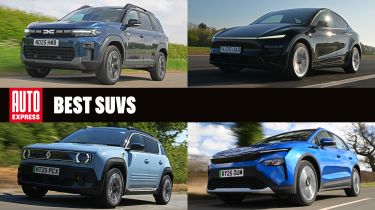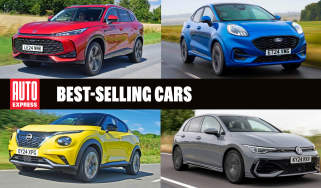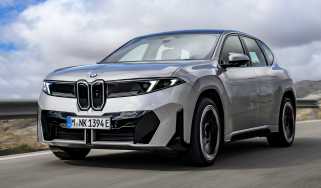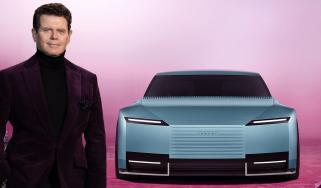Best SUVs to buy 2025
There are plenty of great SUVs to choose from, so we’ve picked out the very best
Choosing the best SUV to buy is a difficult task, not only due to there being so many models to choose from on today’s market but also because everyone has different expectations of what their car should do.
For some, the best SUV will be the model with the most space inside, yet for others it might be the one that looks the best, is fastest, cheapest or has the most technology. Most people have their own special blend of qualities in mind.
Fortunately, you’re in safe hands as our experts have thoroughly tested every SUV you can buy in the UK. We’ve rounded up the top 10 best SUVs below, based on our extensive testing criteria, and we’ve included a wide range of cars to help meet every need.
We’ve selected a wide range of SUVs for this list but if you have more specific requirements then take a look at the the following:
- Best hybrid SUVs
- Best electric SUVs
- Best small SUVs
- Best mid-size SUVs
- Best large SUVs
- Best luxury SUVs
- Most economical SUVs
- Best seven-seaters
The best SUVs list below covers a range of budgets and requirements.
Top 10 best SUVs in the UK
1. Skoda Elroq

- Prices from £31,700
- Auto Express Car of the Year 2025
| Pros |
|
| Cons |
|
As a relative newcomer to the Skoda family, the name ‘Elroq’ won’t be familiar to everyone just yet, so think of it as an Enyaq with a slightly smaller (but still generous) 476-litre boot. Perhaps most importantly, like-for-like it costs the best part of £6k less than its big brother.
While it’s smaller than the Enyaq, the Skoda Elroq still feels hugely spacious inside. Passengers in both the front and rear seats have plenty of room to stretch out, while some ‘Simply Clever’ storage solutions help to keep things tidy.
Often the case with electric models that house their batteries under the car, the Elroq’s floor is a little bit high. This is most noticeable when sitting in the back, but the seat bases have been designed to increase thigh support and keep things comfortable. The Skoda’s 470-litre boot falls short of the Renault Scenic’s 545 litres, it should still have enough space for the majority of day-to-day needs.
Not only is it a good all-rounder in terms of practicality, but the Elroq is also a very pleasant experience from behind the wheel. The powertrains are smooth, responsive and silent, and stepping up to the hot vRS model will get you the fastest accelerating Skoda ever produced (0-62mph in 5.4 seconds).
This being an electric car, there are plenty of potential savings to be had over a similarly-sized combustion-powered SUV. EVs no longer qualify for zero VED road tax, but those with access to home charging can still save plenty compared to filling up with liquid fuel. Company car drivers can also enjoy a low Benefit-in-Kind tax rating.
“The Elroq is so good that we see it creating a bit of a dilemma for Skoda: why would anybody need the larger Enyaq now”. - Ellis Hyde, news reporter, who drove the Elroq in the UK.
Skoda Elroq reviewSkoda Elroq deals
2. Renault 4
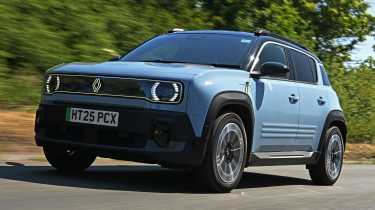
- Prices from £25,500
| Pros |
|
| Cons |
|
The Renault 5 E-Tech is a fantastic electric supermini, but it has just one small flaw: rear seat space can feel a little tight. But fear not, a solution comes in the shape of the new Renault 4.
The original Renault 4 was loved by so many due to its rugged simplicity and practicality. The modern-day model feels classier but the practicality ethos still remains.
Riding on a stretched 5 platform has given the 4 all of the things we love about its supermini relative, but with more cabin space. Adults can now easily get comfortable in the back, and the 420-litre boot is generous for the class. Much like it did on the original car, Renault has endeavoured to make the boot opening as low as possible, too.
The Renault 4 also offers a smoother ride than its Renault 5 sister and, aside from an overabundance of stalks behind the steering wheel, this is a refreshingly simple car to get on with.
The infotainment system is one of our road testers’ favourites, there’s plenty of proper switches and an official range of up to 247 miles is plenty for typical everyday use.
Perhaps the best bit of news is that the Renault 4 starts from only £25,500, which makes it something of a bargain.
“On the road, the R4 continues to impress. It feels neatly tied down, despite Renault claiming it has a slightly softer set-up than the 5, with a willingness to change direction that’s missing in plenty of its rivals.” - Richard Ingram, deputy editor
Renault 4 reviewRenault 4 deals
3. Skoda Kodiaq
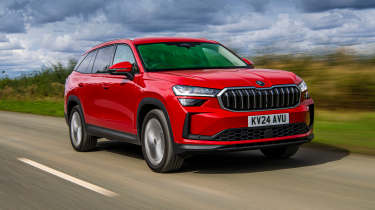
- Prices from £38,200
- Best SUV for families
| Pros |
|
| Cons |
|
For many drivers, the Skoda Kodiaq has become the de-facto large family SUV, and it isn’t hard to see why.
Unlike some cars on this list, the Kodiaq has the advantage of being offered in either five or seven seats. You can either have room for a large family or a smaller family with a huge amount of luggage. The seven-seater still has 340 litres of boot space but the five-seater offers the most at 910 litres.
You’ll also find plenty of the brand’s ‘Simply Clever’ touches, including an ice scraper, a display screen cleaner and even a door-mounted umbrella. Our road testers are also fans of the ‘Smart dials’ - customisable physical dials that provide quick and ergonomic access to frequently used features on the control system.
The Kodiaq is a large SUV, but it does a respectable job of maintaining its composure in corners. There is some body roll, but nowhere near enough to reintroduce you to your last meal.
Buyers have a selection of strong petrol and diesel engines to choose from. We’d go for the latter here; the 2.0 TDI’s (Turbocharged Direct Injection) torquey power delivery suits a car like this well, yet it still returns over 53mpg in official tests.
There’s also a plug-in hybrid powertrain, capable of 75 miles of pure-electric driving thanks to its 25.7kWh battery, although this is only available in the five-seat model.
“The Kodiaq is spacious, efficient and features plenty of clever touches, while the cabin has taken a step upmarket when compared with the first model.” - Dean Gibson, senior test editor, who drove the Kodiaq in the UK.
Skoda Kodiaq reviewSkoda Kodiaq deals
4. Dacia Bigster
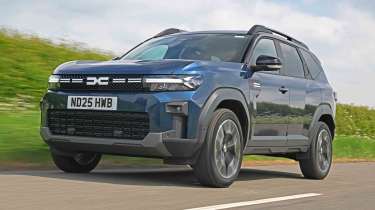
- Prices from £25,200
| Pros |
|
| Cons |
|
Its name has a whiff of a marketing team running out of ideas late on a Friday afternoon, but that’s just about the only thing about the Dacia Bigster that feels half-hearted.
The Bigster clings on to Dacia’s strengths of no-nonsense, rugged charm and value; this Hyundai Tucson-sized SUV starts from around £25,000.
The cabin doesn’t feel as plush as some of its pricier rivals’, but the Bigster’s huge space, its range of strong powertrains plus its kindness to your wallet, will make that easy to forgive.
Those seeking a new family car will also be well catered for by the vast 612-litre boot and sensible passenger space.
Plant your right foot in any variant of the Bigster and the effects are pretty minimal (the quickest model will cover the 0-62mph sprint in a leisurely 9.7 seconds). However, we’re willing to bet that very few buyers are eyeing up this rugged, budget-based SUV for its performance. What the Bigster does do surprisingly well, is provide a comfortable and refined ride, even on motorway runs.
The thirstiest petrol variant returns 46mpg on the WLTP combined cycle, those who want the lowest running costs will want to look towards the two-wheel drive TCe 140 petrol or the hybrid-powered model. Both of these can surpass the 50mpg mark, while the latter is pleasingly responsive when required.
“The Bigster is a decent cruiser at motorway speeds, with a floating sensation to the ride that boosts comfort. The hybrid model switches between petrol and EV drive even at 70mph, with no hesitation in the powertrain as you accelerate.” - Dean Gibson, senior road test editor.
Dacia Bigster reviewDacia Bigster deals
5. Hyundai Santa Fe
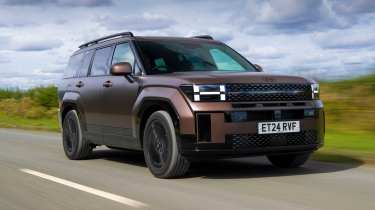
- Prices from £47,900
| Pros |
|
| Cons |
|
Just because a seven-seater is practical, doesn’t mean that it can’t have a shred of desirability, and the Hyundai Santa Fe has proved that with its striking, contemporary look.
The Santa Fe does lean heavily into the boxy approach to styling, this does have its benefits inside. The Santa Fe’s cabin is vast, and accommodation in the third row is more than a match for any of its rivals’. If you don’t need all of the seats, you can always make use of up to 1,949 litres of cargo space with the rear rows folded instead.
A laid-back driving experience perfectly suits the Santa Fe’s character, too, which alongside strong kit levels put it among the most desirable seven-seaters around. As with many of Hyundai's other cars, there are plenty of advanced safety systems to keep everything in check. However, our road testers were driven slightly mad by the incessant chimes.
There’s no fully electric option but the Santa Fe does come with either full or plug-in hybrid power. We recommend steering clear of the four-wheel drive hybrid, unless it’s absolutely essential for your needs, as this only manages around 38mpg.
“The Santa Fe's lofty driving position gives a good view of your surroundings, while all versions feature front and rear parking sensors and a reversing camera to help with manoeuvres. Light steering is also a bonus.” - Dean Gibson, senior road test editor.
Hyundai Sante Fe reviewHyundai Santa Fe deals
6. Dacia Duster
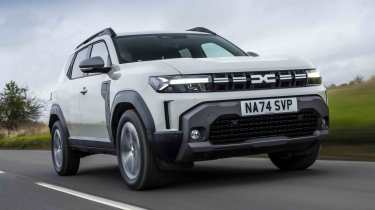
- Prices from £19,400
- Best value SUV
| Pros |
|
| Cons |
|
Value for money is hard to come by these days, but the Dacia Duster really feels like it over-delivers.
While it does feel far less plush than its pricier competitors inside — which is entirely forgivable at this price point — the Duster is sturdy and neatly designed. This will be particularly welcome news for those who are looking for a family car, as they won’t need to worry too much about breakages, marks and tears.
What Dacia’s SUV lacks in poshness is also made up for in space, as all passengers have a decent amount of head and legroom. The boot is also rather roomy, however the load lip is quite high so’ll want to be sure to lift with your knees and not your back.
The Duster is very straightforward from behind the wheel. It’s a bit softer than its rugged appearance would have you believe, although we don’t feel it’s quite as refined as its predecessor, largely due to the boxy shape creating a lot of wind noise at speed. If you fancy a bit of off-roading, the four-wheel drive variants perform surprisingly well for such a low-cost car.
The headline figure here is undoubtedly the Dacia Duster’s starting price of less than £20,000. It’ll also be rather kind to your bank balance when it comes to day-to-day running. Every variant can return over 40mpg and the hybrid is the most frugal option with an official figure of 55.3mpg. There’s even a bi-fuel model available, but LPG (liquified petroleum gas) pumps can be difficult to come by.
“The Duster hasn’t lost its way, because the third-generation SUV offers great-value motoring and family car practicality at an affordable price.” - Alex Ingram, Chief reviewer, who drove the Duster in the UK.
Dacia Duster reviewDacia Duster deals
7. Tesla Model Y
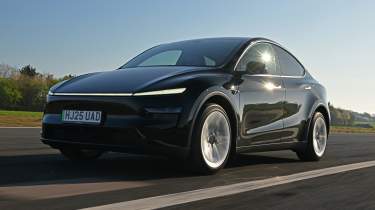
- Prices from £45,000
| Pros |
|
| Cons |
|
Tesla is a brand that frequently finds its way into the headlines, and not always for the right reasons. But the Tesla Model Y remains one of the best electric SUVs on the market.
Even if you’re carrying the full five passengers, each one will have ample room to get comfortable thanks to the sizeable rear bench seat and flat floor. While Tesla doesn’t measure its boot sizes in the traditional way, our road testers can confirm that the Model Y offers a huge amount of luggage space, low loading lip and additional storage solutions that all prove highly useful.
While the previous Model Y had a few weak points in the way it drove, most notably ride comfort and refinement, we’re pleased to announce that the midlife facelift has notably improved these pitfalls. There’s far less noise inside than before, even at higher cruising speeds, while the amount of power on offer ranges from quick to downright ridiculous. For example, the Tesla Model Y AWD will accelerate from a standstill to 60mph in under five seconds.
Tesla’s refresh also improved efficiency, moving the Y even further ahead of its competition. The Long Range Model Y now delivers a claimed 387-mile range, but even the entry-level Standard Range car isn’t too far behind with up to 311 miles on tap.
“The Tesla’s regenerative braking is superbly composed. Nothing in this class can bring itself to a halt with the same limo driver-like smoothness as the Y, which makes low-speed manoeuvres very relaxing.” - Alex Ingram, chief reviewer
Tesla Model Y reviewTesla Model Y deals
8. Volkswagen Tayron
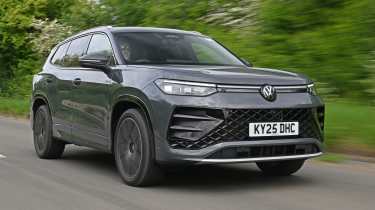
- Prices from £40,200
| Pros |
|
| Cons |
|
Apparently the name Tiguan Allspace wasn’t sufficiently original to separate the seven-seater from its smaller Tiguan sibling. So, it’s had a name change – welcome to the Volkswagen Tayron.
As before, the Tayron closely follows the form of the Tiguan until the second row of seats, where the rear end grows larger and more boxy to accommodate an extra pair of chairs. Some rivals are more roomy, but the Tayron feels more like a compact SUV than a bulky seven-seater to drive.
While the Tayron doesn't provide much in the way of driving thrills, it does feel more comfort-oriented than the Tiguan Allspace it replaced. We felt that the UK’s seemingly endless supply of potholes was dealt with very well during testing.
Although it’s a hefty seven-seater, the Tayron does fare pretty well in the economy stakes. There’s a wide range of engine choices, too, with petrol, mild-hybrid, plug-in hybrid and traditional diesel to pick from.
“The seven-seater uses a sliding middle row to make access to the rear two seats pretty easy, and you can sling those middle seats forward with one hand.” - Alastair Crooks, senior news reporter.
Volkswagen Tayron reviewVolkswagen Tayron deals
9. BMW X3
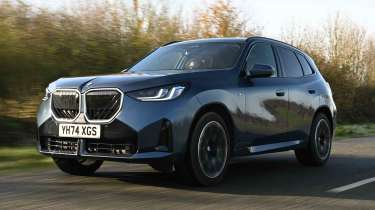
- Prices from £51,600
| Pros |
|
| Cons |
|
The BMW X3 offers one of the best driving experiences on this list; we rate its ride, handling and powertrains as highly as anything else in the class.
The X3 is classed as a mid-size SUV, but the amount of passenger space on offer isn’t exactly remarkable. That being said, nobody will feel uncomfortable, and there’s ample room for an ISOFIX child seat in the back. The best practicality news is that the boot capacity does stand out at 570 litres. BMW also throws in some useful standard kit here including a luggage net, a sliding parcel shelf and a movable floor.
While many people believe that buying a family-friendly car means waving goodbye to driving enjoyment, the BMW X3 is something of an exception to this unofficial rule. While it’s still a long way off the experience provided by this Bavarian brand’s finest sports cars, the X3 feels respectably planted and responsive for its size. Our testers felt confident to push on through corners at higher speeds (although nothing too outrageous), and the suspension isn’t easily upset by imperfections in the tarmac. For maximum thrills you’ll want the X3 M50, as this is powered by a 3.0-litre twin-turbo petrol engine producing 393bhp.
The X3 is a premium SUV, so you’ll inevitably be paying for the privilege. If you want to at least attempt to counteract the starting price with lower running costs, the plug-in hybrid X3 30e xDrive will be the best candidate. On paper, this model can return up to 282.5mpg on the WLTP combined cycle, and exhaust emissions go as low as 22g/km. While it’ll be highly difficult to achieve this three-figure economy in the real world, the PHEV should still prove far less thirsty than its counterparts (provided you keep the battery charged).
"Driving dynamics and tech are two trump cards for the latest X3, while in its weakest areas it’s merely average at worst. Pricing is also competitive when compared against its key challengers." - Alex Ingram, chief reviewer, who drove the BMW X3 in the UK.
10. Hyundai Tucson
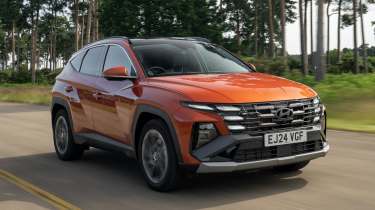
- Prices from £33,100
- Multiple Auto Express Mid-size SUV of the Year award winner
| Pros |
|
| Cons |
|
The Hyundai Tucson bagged our Mid-size SUV of the Year award four years running, helped by its distinctive exterior design and backed up by a smart-looking and impressively spacious cabin with sound ergonomics.
While its predecessors were a tad bland, the latest Tucson looks and feels like a car from a much further up the pricing scale. Not only does it look like a premium car on the outside, but the cabin is equally pleasant, not to mention very well put together. Alongside the smart materials and tech is enough passenger space for four taller adult occupants, as well as 620 litres of boot space (although this drops to 577 litres in the hybrid and plug-in hybrid models).
Stick with driving sensibly and the Tucson is a perfectly calm experience on the move. It’s not quite as dynamic as its looks may suggest, but there’s more than enough shove for overtaking and motorway cruising. Hybrid powertrains, in mild, full and plug-in forms, give buyers plenty of choice, and while the Tucson is not the most thrilling SUV to drive, that’s not terribly important for a car such as this. What matters more is that it feels reassuringly solid to drive, with surefooted handling and great comfort.
The Tuscon plug-in hybrid has the edge when it comes to efficiency, too. Although Hyundai’s claim of up to 201.8mpg will be monumentally difficult to match in anything but a laboratory setting, this version should still prove very economical — provided you keep the battery topped up. If you don’t fancy a plug, the petrol and hybrid variants are still capable of over 40mpg.
“I think the Tucson’s interior is one of the roomiest in the class and the boot is large enough to rival those of estate cars.” - Ellis Hyde, news reporter, who drove the Tucson in the UK.
Hyundai Tucson reviewHyundai Tucson deals
Best SUV priority factors
Exclusive research by Auto Express has underlined just what a demanding bunch SUV buyers are. We asked SUV owners what their top priorities were when looking for a new car and the results confirmed what we already thought, that buyers in this sector want cars that can do it all.
- Value for money was the key priority for SUV buyers with 52.6%.
- Reliability was chosen by 50% of respondents.
- Comfort was the third biggest priority with 48.7% of people choosing it.
- Cabin and boot space tied with running costs as the fourth biggest priorities on 37.8%.
We want you to find the best SUV for your needs and so these buyer priorities are baked into our testing processes for cars in this class. Here’s how we go about it...
How we tested to find best SUVs
We’ve tested every new SUV currently on sale in the UK, most of them on multiple occasions.
Our expert road testers typically get behind the wheel on the international launch events and then again on UK roads where we carry out intensive group tests to compare top models head-to-head against their rivals. Some SUV models even come in for a six-month long-term test where we really get under the skin of what it’s like to live with day-in and day-out.
Over the course of the evaluation process we try the full range of engine options and specifications, taking our own precise measurements of important areas like the rear seats and the boot. This helps bring you a complete picture of the best SUV models on sale, and the ones that aren’t up to scratch.
It’s a continually evolving picture with more and more SUV models being launched all the time, so we’re constantly updating and revising our reviews to keep you informed. You can discover more about how the Auto Express expert team review cars here...
Find the SUV of your dreams! Our nationwide dealer network has some fantastic cars on offer right now with new, used and leasing deals to choose from...
Check out our Sell My Car service for a great price when selling your car too...
Best SUV deals

